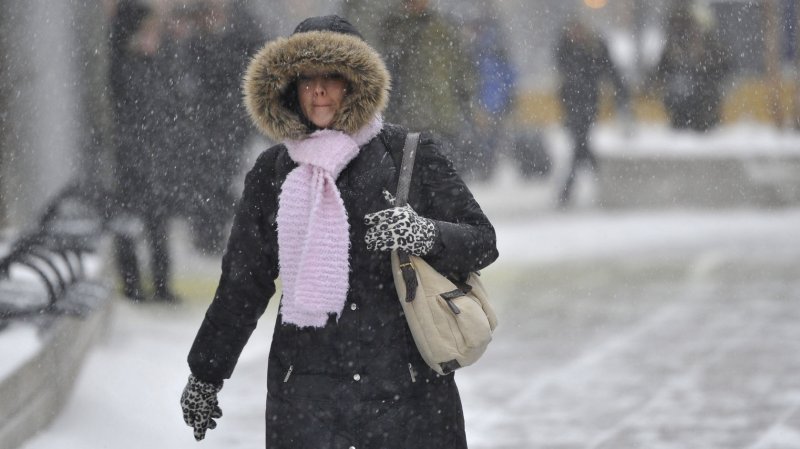A Pedestrian walks through the streets as a major snow storm hits on February 1, 2011 in Chicago. Up to two feet of snow is expected to fall in the Chicago area as a winter storm created blizzard conditions from the southern Great Plains to the upper midwest on Tuesday. UPI/Brian Kersey |
License Photo
BOSTON, Feb. 8 (UPI) -- Gov. Deval Patrick ordered drivers to stay off the roads Friday as Massachusetts braced for what was predicted to be a 100-year blizzard.
Patrick declared a state of emergency, saying that would allow officials to "implement emergency measures to ensure the safety of our residents and take appropriate steps to mobilize state assets."
Only a few flakes had fallen by mid-morning in Boston, The Boston Globe said. Patrick was anticipating a storm that could bring as much as 2 feet of snow, accompanied by winds as strong as 70 mph.
The travel ban, unusual in a state used to winter storms, was to take effect at 4 p.m. EST. Forecasters said the storm would hit full force during what would normally be the evening rush hour.
Gov. Lincoln Chafee declared a state of emergency in Rhode Island, the Providence Journal reported, and Gov. Dannel Malloy declared a state of emergency in Connecticut, The Hartford Courant said.
AcccuWeather.com said the storm likely would cause coastal flooding and power outages as well as white-out conditions and massive drifts.
Airlines suspended thousands of flights in and out of airports in New York and Boston, Amtrak announced it canceled service between the two cities, and schools either closed or dismissed early.
Forecasters said the snow would be heavy and wet.
The worst of the storm was expected to hit coastal areas of northern New England and southern Nova Scotia later Friday night into Saturday, AccuWeather.com said.
On New York's Long Island -- which could receive more than 18 inches of snow -- the power company promised customers it was prepared, The New York Times reported. The utility was heavily criticized for its response to Hurricane Sandy last year.
In Boston, where snow started to fall around 9:30 a.m., schools were closed and mass transit in the city was to be suspended starting at 3:30 p.m., officials said.
Patrick told non-emergency Massachusetts government workers to stay home and urged private employers to issue similar stay-at-home orders.
Snow fell early in New York and was expected to become rain before turning back to snow late Friday, forecasters said. Between 10 and 20 inches of snow were expected to fall by Saturday afternoon in the New York City region.
New York Mayor Michael Bloomberg, criticized for the city's slow response to a 2010 snowstorm, tried to reassure residents that the city was prepared. He urged people to leave work early if possible, the Times said.
"Our biggest concern is making sure that people get home from their day and that they don't abandon their cars in the middle of the road," Bloomberg said. "But we don't think the snow is going to come down hard enough where that should be a problem."
The storm -- which forecasters said could be the biggest blizzard some cities have seen in a century -- is the result of two weather systems colliding and producing one powerful force.
"The storm should reach its peak intensity early Saturday morning just east of Cape Cod," the National Weather Service said in a statement.
Because of expected hurricane-force winds, NWS predicted "dangerous blizzard conditions" for many parts of Northeast.
Winter weather and blizzard warnings were in effect from Pennsylvania through New Jersey and metropolitan New York all the way to Maine, the National Weather Service said.
At the storm's height, snow could fall at 2 to 4 inches per hour and may be accompanied by thunder and lightning, AccuWeather.com said.
The Weather Channel named Friday's storm Nemo, but the National Weather Service declined to give it a name.
"We never have, nor do we have any plans to consider naming winter storms," a weather service spokesman told the Times.















